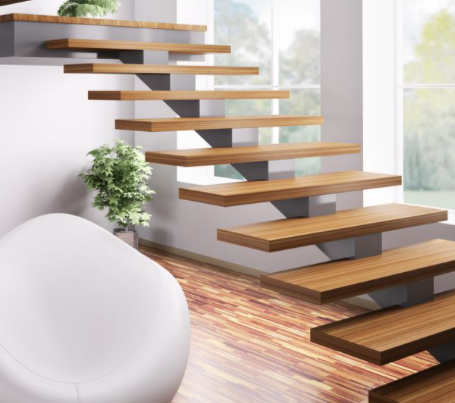One of the few downsides of hardwoods, especially on stairs, is that their smooth polished surface can be slippery.
 By adding carpet, anti-slip adhesive stair treads, or applying a coat of anti-slip floor finish to the surface of each step, the easiest way to make your hardwood stairs less slippery is to add traction. All three of these strategies make the surface of each stair rougher, add stability, and reduce the chance of slipping dramatically.
By adding carpet, anti-slip adhesive stair treads, or applying a coat of anti-slip floor finish to the surface of each step, the easiest way to make your hardwood stairs less slippery is to add traction. All three of these strategies make the surface of each stair rougher, add stability, and reduce the chance of slipping dramatically. No more than 7 3⁄4 inches tall should be any stair riser. Each staircase should be at least 10 inches deep and at least 36 inches high. Your handrail should be at least 1.5 inches high and clear of the wall, but not more than 4.5 inches, between 34 and 38 inches. For each staircase, you are expected to provide at least one handrail, but it is highly recommended to install handrails on both sides for additional support.
Here are the ways in which you can make your stairs less slippery and methods researched by cleaning service Sherborn, so that you can determine which one is right for you.
Carpet Installation
Carpet construction is one of the most common methods of making stairs less slippery. Not only does the carpet make the stairs smoother by providing surface traction, but it can also be a fun addition to your home's decor.
You have two choices, stair runners or carpet stair treads, when it comes to carpet.
Runners of Stairs
Stair runners are bits of carpet that run down your stairs, but each stair does not cover the entire width.
The benefits of stair runners are that they cover the full depth (not the width) of each stair tread, protect the wood from damage, minimize noise, look fantastic, and make your stairs less slippery, most importantly.
Stair Treads carpet
Your second choice is to use carpet stair treads, if you want to go the carpet route. Carpet stair treads are individual pieces of carpet that can be placed on each level separately.
The major advantage of Carpet Stair Tread over stair runners is that they are easy to mount.
Carpet treads are less costly and much simpler to clean than using a carpet. You can quickly remove the treads, clean the wood underneath and scrub or soak the treads in soap and water. Most significantly, the fibers of carpet treads provide stability if installed correctly and reduce the chance of slipping.
Using Stair Treads with Anti-Slip Adhesive
Look down the next time you are in the stairwell of a commercial building. To stop falling, you'll probably see thick black grip tape on each stairway. It would not be a good look for black tape on wood stairs, plus commercial treads have a rough sandpaper-like texture that would rip your feet off.
Apply the Floor Finish Anti-Slip
A liquid solution that you can add directly to your wood stairs to make them less slippery is the anti-slip floor finish. If you don't want to alter the appearance of your stairs by adding carpet or don't want to deal with the minor problems that clear adhesive stair treads present, using an anti-slip floor finish is an excellent choice.
Make certain that your stairs are up to code
On stairs that are old and no longer follow the building codes of today, incidents are more likely to happen. You're putting yourself and others in your home at risk if your stairs don't have enough depth or the gap between each stair is too big.

